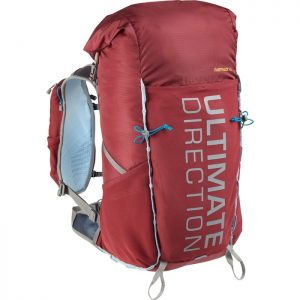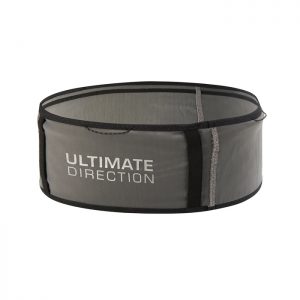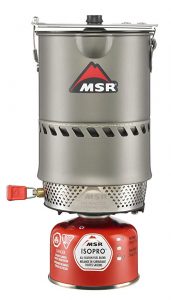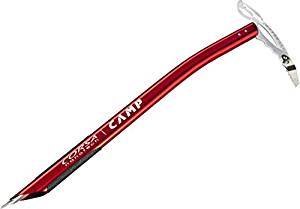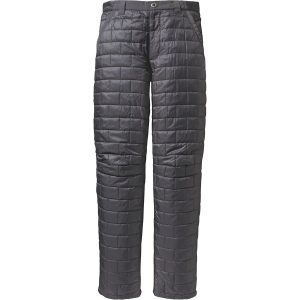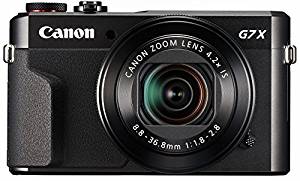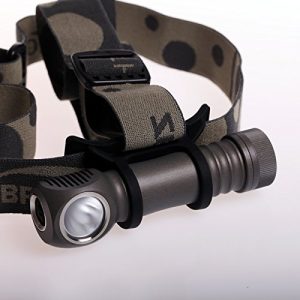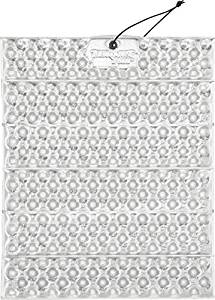Here’s a link to the below in a simple spreadsheet form.
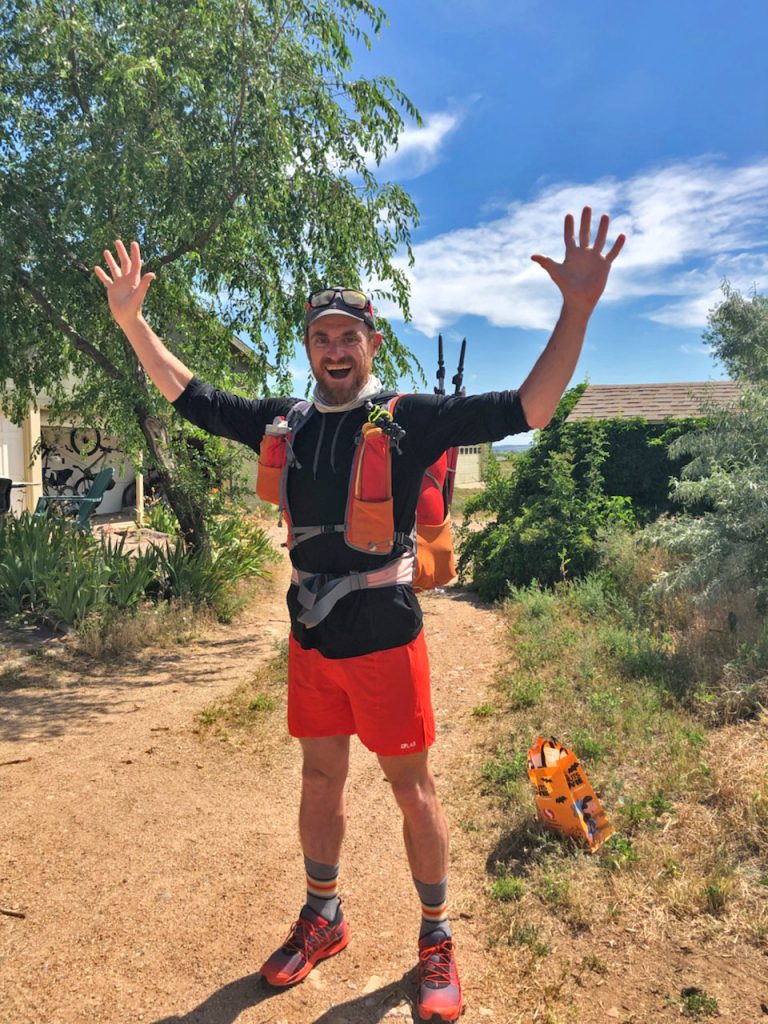
The Sangre de Cristo Range route as an unsupported fastpack carries with it a lot of logistical puzzles one has to solve before the trip becomes realistic.
Yes, one has to be in good physical condition to take on the distance – and more importantly: the elevation gain of the route, and be proficient in scrambling efficiently up to low Class 5. The right footwear has to be picked out to be useful for both traveling long distances off-trail, as well as sticking well enough to a side of a cliff.
Along with this, the entire weight of your gear + food + water needs to be low enough where getting to the finish before running out of food is a realistic goal. Too much food, and you’ll be weighted down so much your speed will suffer; too little food, and you just won’t be able to make it to the end without starving.
A ridgeline at 12,000′ – 14,000’+ in elevation isn’t always the friendliest place to be on. At the best of conditions, the sun is unrelenting – no shade at the crest of a divide. Storms: snow, hail, and most dangerous to you: lightning, blow in quickly and seemingly out of nowhere. Too little gear, and you run the risk of being in an emergency situation of your own making. But you can’t bring everything, for every situation.
Water is another major issue: where to get it, where to store it, how much to store it, etc. Being on a ridgeline for the majority of the route leads to a major issue of well: there really is not very much free water available. A mountain creek doesn’t usually start at the crest of a ridgeline but instead at the bottom of an alpine lake, which itself is fed by a lingering snowfield.
One option is to drop down to where this free water is, taking valuable time, and adding to the already stout total elevation gain. Another option is to bring a stove (added weight!) and make water from lingering snow fields on the ridge that are hopefully at convenient locations, and will continue to be conveniently there for you, for over 100 miles – much of which you cannot see beforehand. This means the route is only in condition to do this for a few weeks out of the year (if you’re lucky).
Careful consideration was done to pick out the best gear for the job, and leave everything not absolutely required at home. This gear list is going to be wildly different than the gear list you would create for vastly different terrain like the PCT, or AT. Different problems to solve. If you went out with a backpacking system geared specific for the AT onto the Sangres Range Traverse, you would die.
Below is my complete gear list of what I took, and why.
Total Weights
- Gear Weight: 10,365 grams/22.9 lbs
- Food Weight: 6,025 grams/13.3 lbs
- Total Combined Weight: 16,390 grams/36 lbs
Fastpacking Gear
Ultimate Direction Fastpack 45
1,069 grams
The big-daddy pack that Ultimate Direction puts out. I could have managed perhaps with the Fastpack 35 as I’ve done 5 days with that size pack before, if I wouldn’t have minded lashing my sleep system to the outside of the pack. The 35 would be a more comfortable pack in most cases – the 45 just seems a bit too big for the running-vest-as-backpacking-pack design.
But, I actually did mind: I wanted a clean looking system without anything extra to fiddle around with. I wanted things I didn’t need during my hike to stay in the pack in a safe place. If I need to run after my four pound sleep system I’ve inadvertently dropped 500 feet down the ridge because I lashed it on the outside of the park in a sloppy way, it defeats the purpose of going with a smaller pack just to save a few grams.
The advantages of the Fastpack 45 are that it really doesn’t have a true hip belt – it has what appears to be a hip belt, but it’s far too high, and doesn’t have enough rigidity to truly rest on your iliac crest (or at least this is my observation for my body- bodies are variable, of course).
All the lowest, widest strap does is stop much of the sloppy swaying that may happen if you are running with it. This allows a ton of freedom of movement – there’s a lot of scrambling on this route, and I want to be able to move my body as it needs to.
The disadvantage of this pack is the exact same thing: no hip belt. A 45 liter pack filled with what I’m putting in it is most likely above most people’s limit on what’s acceptable to keep most weight on one’s shoulders.
For example the last time I went out for 6+ days in an, “ultralight” setup was with an Osprey Atmos 65 Liter pack – an altogether different category of packs.
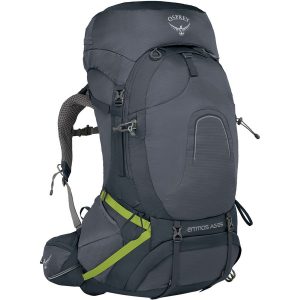
This Osprey is a good pack, just not one for this terrain. Too bulky, and you wouldn’t want to fill sixty five liters of storage space – unless you’re really interested in being on route for 9+ days, which I’m telling you: you don’t.
Back to the UD 45: I have a fairly well-developed upper body (and an extreme talent (my only) to handle low level amounts of pain for long periods of time), thanks to all the climbing I do, so I can sort of take the brunt of all this extra weight. If you don’t, reconsider this size pack for this type of running-vest-forward design. This pack also has no real frame – internal or external; just a foam pad to rest on your back. That makes it light – but that also comes at a price of pure comfort. You should see these compromises from a mile away.
For everything else, the pack ticks the boxes of what I need: a large, no-nonsense main pack interior to stuff my food, sleep system, clothes, electronics, and personal items (each in their own individual waterproof stuff sacks c/o Sea to Summit), two side pockets to put things like extra water and trekking poles in, and a back pocket to carry things like the day’s food and a few changes of clothes, so I don’t have to rummage through the main pack compartment. The running vest-style gives me pockets in front for my phone, a 20 ounce water bottle (old school/rigid/bike water bottle-style – I’m a soft flask/Body Bottle holdout/curmudgeon), my GPS, a bug headnet, and some other random accoutrements. I added a small camera bag to one of the pack’s straps to keep my camera, freeing one of the main pockets, which worked well.
Since I brought an ice axe, I also utilized the pack’s ice axe loops, and used the daisy chain to afix my Garmin Inreach Mini’s adorable mini-carabiner too. There was no option to lose the Inreach Mini, so I was really putting my trust in the daisy chain, and this little ‘biner.
There’s one modification that the lead designer at UD and I made to the pack, and that was to add an extra layer (about 1-2mm) of rigid plastic to the back foam padding to make the back of the pack a little more rigid and have there be less of a chance of stuff in the pack poking me in the back in weird ways. This did cause an additional issue though: the sharp edge of the rigid plastic then dug into my lower back. I fixed this on the route by stuffing my running singlet inside the pack’s internal pocket where it was digging into my back for additional padding on my lower back.
Finally, I should say something about the colorway: it’s a bright flame red/orange! How rad. This is not a production color (past, present, or future); the pack is actually a one-of-a-kind production sample, and the fabric used were just factory scraps that were on hand. No idea if there were any other modifications done to the pack – I suspect there wasn’t, except for minor things like sourcing plastic buckle bits from another supplier or something. I took the flame red as a cue on how to design the color scheme for the rest of my gear – if we’re going into the Sangres, it’s going to be about blood (or say: self-sacrifice), about heat, about standing out like those amazing alpine glow sunrises/sunsets.
Ultimate Direction Utility Belt
74 grams
One trick of moving fast with a heavy pack, is to limit how many times you need to take off/then put back on the pack. Enter this very useful accessory. The UD Utility Belt has pockets of various sizes that are perfect for putting things like the small baggies of food that I had prepared ahead of time. No need to rummage in the pack itself – I had thousands of calories at hand.
In a few cases, I dropped my pack to tag a peak on the ridgeline and stuffed my phone, GPS, and inReach Mini in the Utility Belt – Milwaukee Peak is a prime example. On the peak, I could send a message on my inReach, take a photo with my phone, and record/navigate back to my pack with my GPS.
For it’s price, weight, and simplicity, this may be the most useful trail running accessory ever.
Black Diamond Trail Ergo Cork Trekking Poles
490 grams
Dependable poles. I’d use something a little more UL (BD Carbon Z Poles, perhaps?), but being hard on gear, I’d probably break something lighter, like the Z Poles.
Julbo Stream Polycarbonate Sunglasses
133 grams
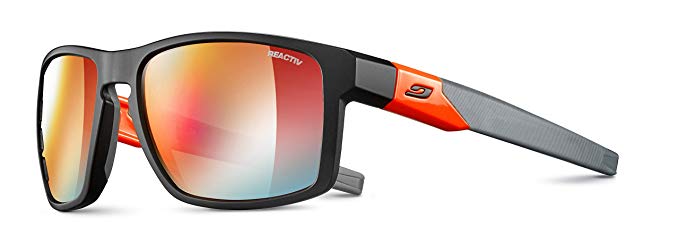
This was my first attempt at using photochromic (“Reactiv” in Julbo’s parlance) glasses, and I think they worked well. A ridge is a really sunny place to be onall-day, and I perhaps wished these lenses got even darker then they did. I brought a backup pair of sunglasses that were definitely darker just in case these didn’t work or were lost, but never put them on, so maybe they were actually perfect. Never did get a headache from too much sun exposure or anything like that.
MSR Reactor Stove, 1 Liter
672 grams
Clutch piece of gear, and one I bought specifically for this trip. Big problem with long ridge runs is: where do you get your water? You’re just not going to cross any streams. Dropping down off the ridge proper takes time, and any elevation you lose, you’ll have to gain back without any forward distance covered. This route has enough elevation gain/loss, I’d rather not add anymore than required.
Answer is: snowfields. So, I needed to time my trip to make sure there was snow on/near the route, but not so much snow that my speed of travel would be impacted. Snow could then be melted down for water using a small stove.
2019 had an incredible wet/snowy Spring – so much, that I delayed my trip by an entire month to get snow levels to the point where there wasn’t so much snow to make the route actually unrealistic!
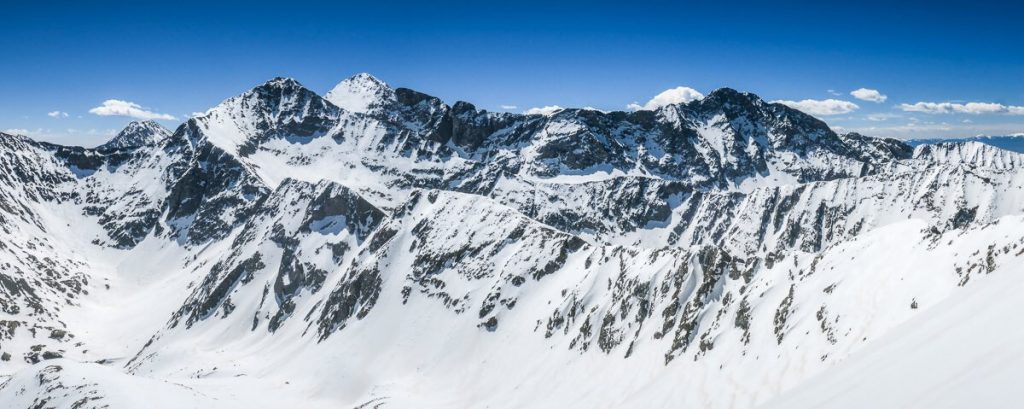
This strategy in the end: worked. Best thing to do (after some trial and error) is to only melt small amounts of snow, then heat it a little further past 32 degrees F. Then, add this warmed up water to a larger amount of snow in a bladder. I had to also be very frugal with my fuel as I only brought the smallest canister I could buy (at 3.2 ounce).
The entire stove system fits together in itself neatly, and took up very little space in my already tightly-fitting pack.
I specifically picked this stove since it was touted to be economical with its fuel, lightweight for the performance it would give, fast with its boil times, and would work in windy locales (like again: a ridgeline).
I found all these things to be true. This stove would be at home on Denali.
Clothing
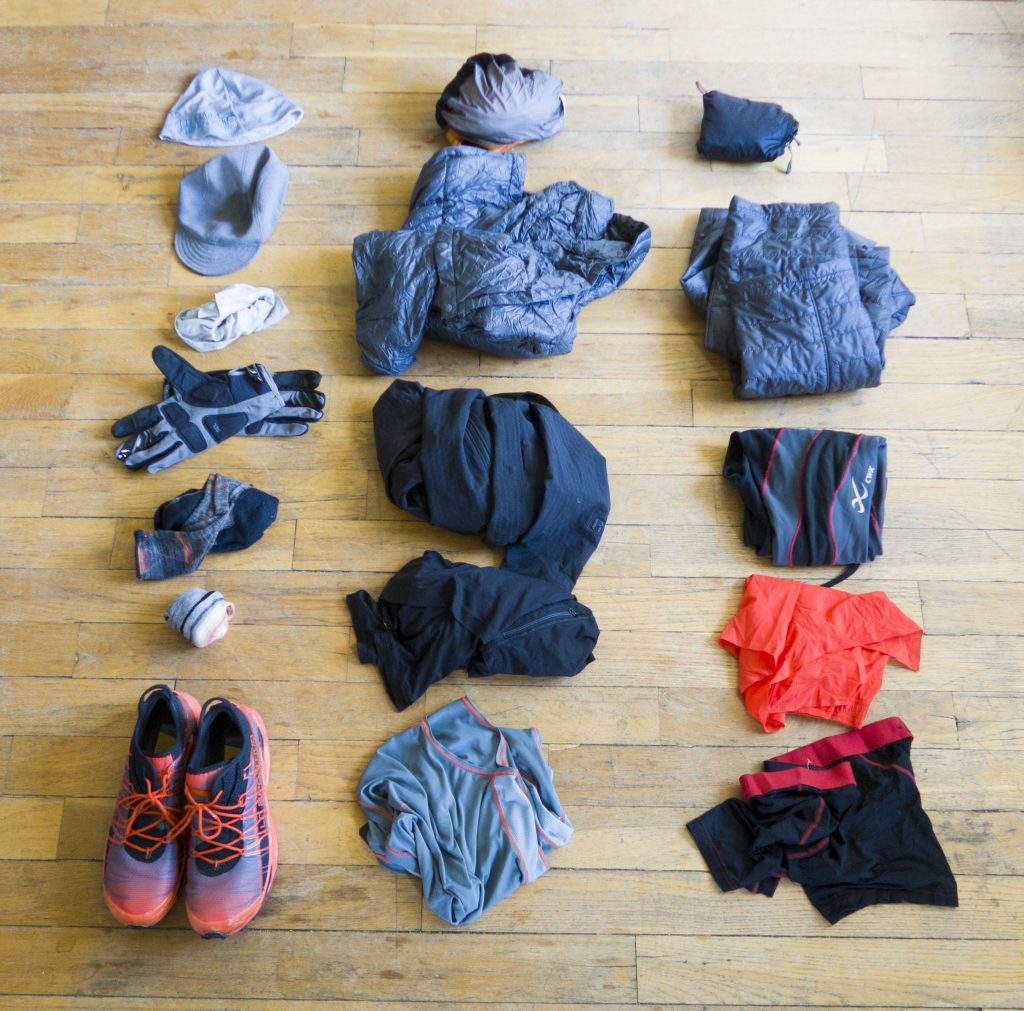
Feet
La Sportiva Mutant
748 grams
I’ve preferred the Mutant for most anything that deals with trail running, off-trail scrambles, and fastpacking – I even used them when guiding backpacking trips in Alaska (and I wouldn’t have used anything else). I haven’t actually worn anything else on my feet for a while now, save the La Sportiva TX2 for all the delicious scrambling we have close at hand in Boulder.
The shoe’s last is one of the wider (if not the widest) that La Sportiva offers, which helps fit my foot correctly. As a comparison, the La Sportiva Bushido is probably just a little too narrow for me.
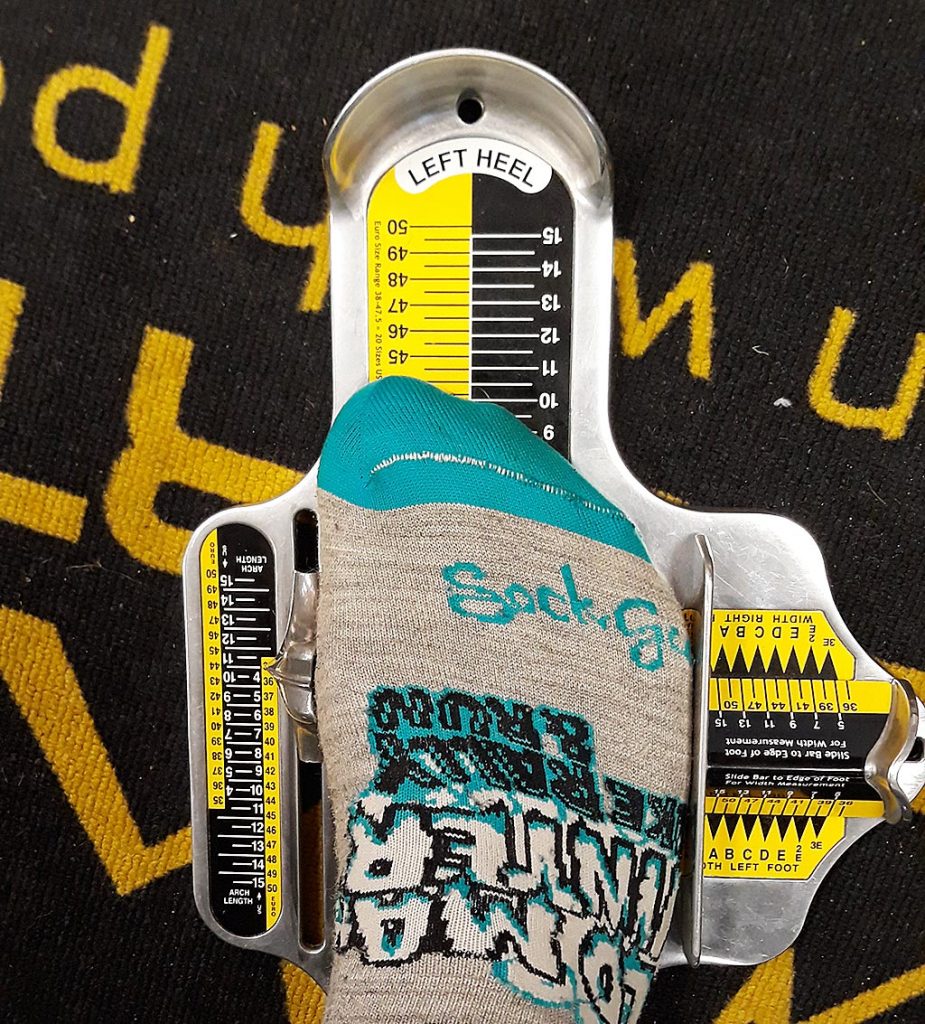
The outsole of the Mutant is very chunky – good for grip in various surfaces (mud, scree, etc) and the rubber itself is pretty sticky for a trail runner. That last point is good, since there’s some legitimate climbing on the Sangres route. They’re not my TX2‘s, and certainly not my Miura VS’s, but they’ll get the job done when the going get’s 5.easy.
I played with the idea of doing the entire route in a pair of TX3‘s, but the Mutant would just be more comfortable in the long run. I never even thought about bringing two pairs of shoes; too much weight/hassle.
If there are some weaknesses to the Mutant, it would be the upper. The mesh material is great for breathe-ability, but the amount of abuse the shoe takes when swimming in endless miles of scree and talus will cause damage to this mesh near your little toe. If I was smarter, I would have preempted this damage with a bit of Aquaseal to reinforce this area, but I was not.
Another weakness of the Mutant are the laces – they just don’t last when (again) abused. And again I should have replaced the laces before the trip – even though the shoes were new. But, I did not. They did, in fact, break. Easy fix in the bush (cut the damaged part off, seal it back with the flame from a lighter), but it was still an annoyance. Finally, the lacing design is asymmetrical, so if you do need to replace the laces, do them one at a time, so you have a template on how to lace them back up properly.
The La Sportiva Ultra Raptor would have been another great choice for this project as well – sticky sole, same wide last. The upper is probably even better for taking abuse, and I think the midsole has a rock plate even! I was planning on putting in rock plate inserts (made out of an old milk jug) in the Mutant, but forgot them at home.
I managed to go without a gaiter of any sort, but the Mutantcan let in some debris. If I was on less rocky surfaces (and more sandy surfaces), this might have also been a big annoyance, but I only remembered emptying out my shoes once or twice on the trip of debris. The Mutant’s outsole design is flat, and wrapping a gaiter’s strap around its bottom will most likely leave you with a broken gaiter strap (fyi).
Smartwool Crew-Sized Socks, Two Pair, Light and Medium-Light
Wool socks – one pair lighter than the other.
Camp Corsa Nanotech Ice Axe
233 grams
Perfect conditions for this route meant I needed a fair amount of snow on the route to make water with. Being in the alpine, “fair amount of snow” meant I was in for a snow climb or two in the higher, steeper, more protected (from the sun) parts of the route – most notably: the Red Gully and Northwest Couloir of Crestone Peak. Without a proper ice axe, I couldn’t make this trip happen – the terrain would be too treacherous – I was taking chances already by not bringing crampons.
The Camp Corsa Nanotech is a great axe I’ve had for a few years now. It was a perfect accessory for what I needed to do. Light enough that I didn’t really mind carrying it for the 119 miles that I didn’t have any real use for it!
Head
Ultimate Direction Midcap Beanie
19 grams
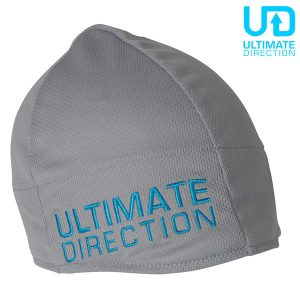
This (really) isn’t sold anymore – a freebie piece of gear at a UD holiday party, but it’s just a simple and light beanie made of nylon – more of a sweatband with a topper. I like it. I didn’t feel the need to bring a warm (and heavy) hat, as I had a Buff and an R1 with a hood, but this was nice to just take the edge off things, as well as to sleep in.
Showers Pass Portland Hat
66 grams
This is a cycling casquette that I just seem to prefer wearing on my head in most waking hours of the day, no matter what I’m doing. Lighter than a trucker cap. You may want something to wear with more sun protection, as ridgelines don’t have too much shade built-in.
Buff UV Insect Shield
39 grams
It’s a Buff, and does Buff things. Initially bought for Alaska, I was amazed (and terrified) at the amount of mosquitoes in the Sangres, so perhaps the Insect Shield helped me out in not being totally and literally being bitten to death.
Hands
Pearl Izumi Men’s Cyclone Gel Glove
106 grams
I dislike thin glove liners (they get torn apart), but I do love these Pearl Izumi cycling gloves. These take abuse, are plenty warm, and have padding on the interior that seems to also work well for using with trekking poles. Tip: if you’re size XXL (like me), the Pearl Izumi outlet store in Silverthorne, CO usually has these for like $15.
Upper Body
La Sportiva Men’s Rocket Tank, Large
102 grams
I like sleeveless uppers, and not just because I want to show off the guns. When layering (and with my larger-than-normal arms), too many sleeves will cut off my circulation. I also run hot and would actually prefer to go shirtless most any time I can get away with that, but carrying a load on my back makes that a dicey proposition; being pale on a sunny ridgeline for days also makes this terribly unrealistic.
Sportiva soft good sizes fit smaller than you may expect, so size accordingly. I’m usually a medium on most gear, but I dip into large and even extra large with Sportiva.
Outdoor Research Men’s Echo Hoody, Large
141 grams
Speaking of the sun, I haven’t figured out how I survived doing what I do without a sun hoody. This piece is in the Clutch Gear Hall of Fame. To keep cooler, I’d wear this alone without the Sportiva running singlet.
This piece also seems to run small, so I opted for a large, which I’m happy with.
Patagonia Men’s R1 TechFace Hoody, Medium
427 grams
If it’s been done, it’s been done in R1, right?
Good midlayer, no complaints. Initially bought a large, but was swimming in it. Downsized to a medium and it was perfect. If anything, the R1 seemed a little heavy/bulking for this type of trip.
Montbell Superior Down Jacket Men’s M
209 grams
I’m not sure of the specific model, but I have a UL Montbell down jacket that’s very light I found at Boulder Sports Recycler. No hood. Used primarily for napping/sleeping. I would usually say a down jacket with no hood is sacrilege, but it was an easy way to cut off grams when the conditions allowed. The R1 had a stout hood, I’d survive out there. Sometimes too many hoods becomes a problem.
La Sportiva Odyssey GTX Jacket, XL
223 grams
(note size: XL)
A great, simple, light, Goretex running jacket that’s waterproof. Wasn’t planning on being in a rainforest, so this is all I wanted to bring.
Lower Body
Exofficio Give-N-Go Sport Mesh 6in Boxer Brief, M
70 grams
I’ve never done a trip without running shorts that don’t come with their own liner, so going with liner-less shorts and (gasp) underwear was a new thing for me, and somewhat of a gamble. Turns out it’s extremely comfortable and I would say: less stinky. I may never go back to lined running shorts.
Had no problem with these riding up.
Salomon S-Lab 6in Short, M
59 grams
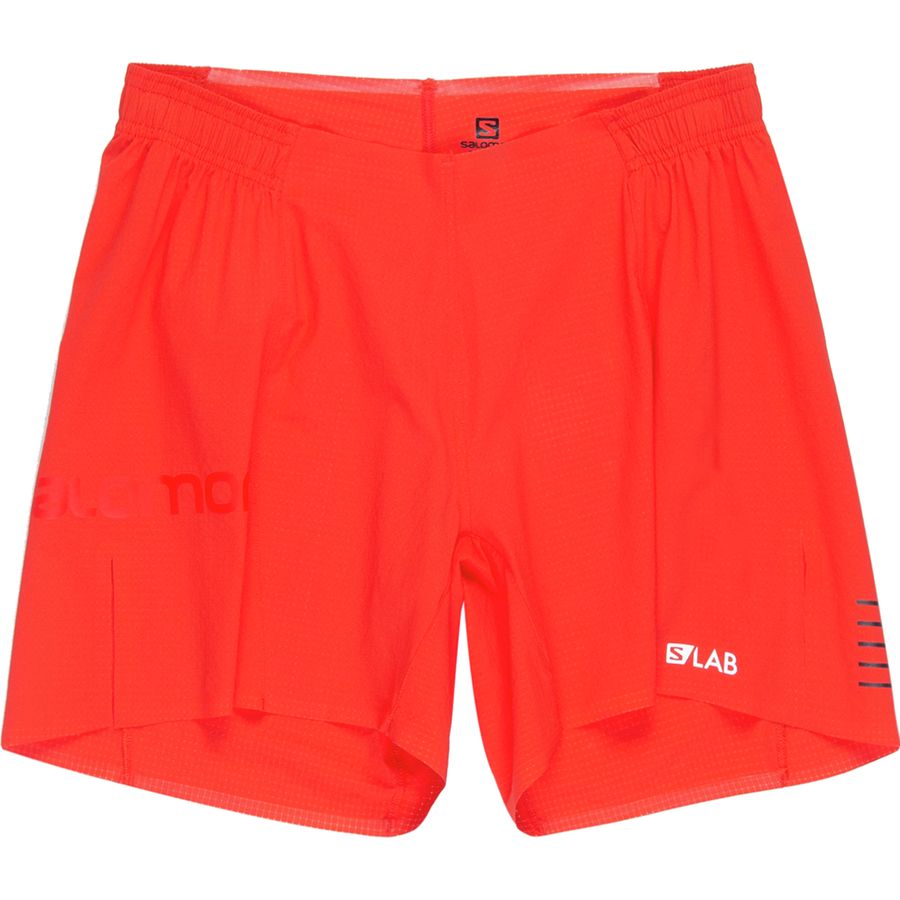
Some pretty lightweight, liner-less shorts. Maybe a little too lightweight with the bushwhacking on route. Did the job. Upon washing them, the dirt seemed to stay clung onto the fabric. So, if you get dirty (like me) and want to look immaculate in future wearings, maybe not the shorts for you. Perhaps these shorts, paired with the underwear above left maybe a little less to the imagination that I would have liked, but you know: I hang in cycling bibs much of my waking hours, so I must be comfortable with making others…. not (so apologies).
CW-X Compression Tights, M
314 grams
Midlayer for my lower body. I don’t really buy into compression garments having magical qualities, but I want a snug running tight that’s warm, which are what these are.
Patagonia Men’s Nano Puff Pants
344 grams
I was wondering if these were going to be useless – or at least overkill for what I needed, or if they’d find a way into my cold, cold heart. Turns out, it’s the latter: totally clutch gear to keep real warm.
Mostly used to stay comfortable during naps on the ridgeline, and sometimes while taking longer sleeps in my bivy. For very light and fast trips, I could see losing the sleep system all together and just having these coupled with a down upper for 45-90 minute cat naps.
I’m also looking forward to packing these during my guided trips in RMNP in September, as they’ll work great for camp time/dinner time.
Outdoor Researh Men’s Helium Pants, L
170 grams
Lightweight pair of rain pants. I generally will attempt to do without rainpants (even in the rain), but still feel the need to pack them – consider the scenario: I’m stuck on a ridgeline, it’s hailing golf balls, the temperature has dropped 30 degrees and I need to keep both warm and dry. Yup: I want rain pants.
Electronics
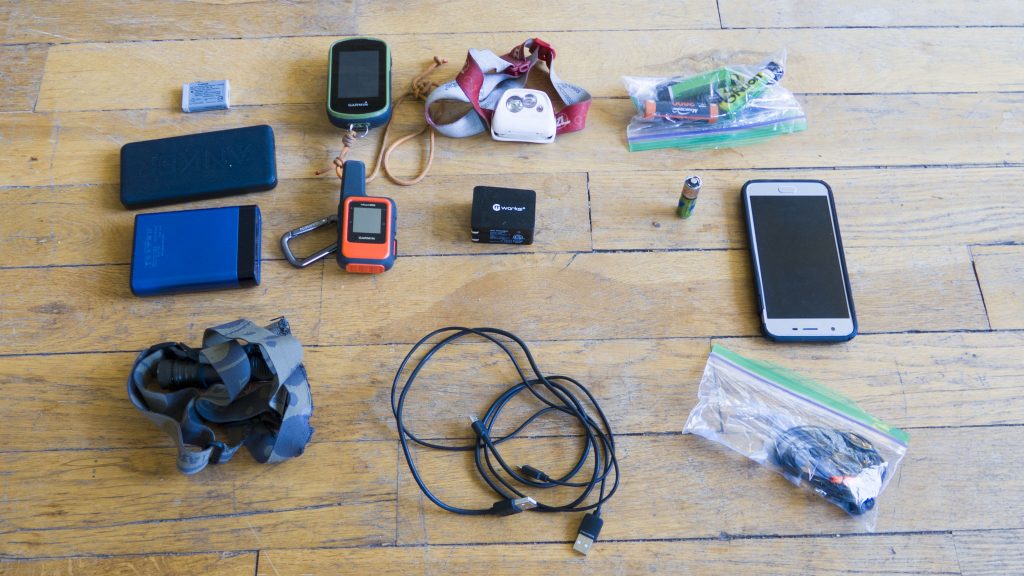
Garmin eTrex 35t
116 grams
I use a dedicated GPS still – I feel that this makes me in the minority (or at least in the minority where I use a GPS unit, and not a GPS watch). I like that it’s not my phone (and thus if it gets lost/damage, I also don’t lose my phone), I want to record a track that has a fairly precise line to it, I find the maps I can load into it (shout out to Above the Timber) work really well, and I find I can see the screen even in direct sunlight.
The 35t is on the cheaper end of Garmin’s offerings. I use it for everything from bikepacking, to longer runs, to things like, well: this. Needs 2 AA’s to run, and I brought along 6 pairs of non-rechargeable lithiums, as they would give me the longest runtime – much longer than rechargeables I usually use.
The AA requirement is one of its strongpoints as far as I’m concerned – easy on long trips to find AA’s most anywhere that’s open. One of its weaknesses though, is that you cannot charge rechargeable batteries by connecting the unit to a USB part, as you can on some more expensive Garmin units.
Another weakness is that the screen becomes unresponsive when wet, which can be annoying:
I did have one issue with my track becoming corrupted while it was recording, which is a bummer, but I did have a backup track being recorded on the inReach (in the Cloud, even!). I guess the lesson there is keep the screen locked as much as possible.
One modification/addition to the unit is a tether, so even if I dropped it, it’s not lost. Often I would just have it hanging off the end of the tether as I was walking around.
I do find apps like Gaia to be very useful – but also supremely buggy. Maybe in a few years, I won’t need a Garmin. For now, I use it as a backup.
Garmin inReach Mini
113 grams

Another clutch device – never will I go on a 12+ hour outdoor mission without this. Tracking on the inReach map works really well. I had the unit set to track for 10, 20, and 30 minute intervals. The shorter the interval, the more battery it’s going to take. I think 30 minutes/ping is just fine when going <1mph.
The inReach messaging also seemed to work pretty well – I was able to send/receive messages in clear skies. If I was in the middle of a storm, it worked less than perfect. For the vast majority of my messages, I just wanted to note when I had summited.
Search and Rescue actually messaged me preemptively while on Eillingwood Point to make sure I was alright. How’s THAT for service? Buy your CORSAR cards, everyone.
Battery life is pretty good – I charged it 3-4 times during the trip, but it never went below 50%. I think with limited messages going out, and tracking set to no more than 30 minute intervals, you could really stretch out this devices battery life.
Pairing with the Android App (called, Garmin Earthmate) worked as well, although you will need to have Bluetooth enabled on your phone. I had my phone on Battery Saving with most everyone I could turned off, so I used the app sparingly.
The inReach Mini also allowed for live FKT monitoring! Which, I didn’t actually knew was going on, but someone was pulling the data off my public inReach map, so that’s fun.
I didn’t have too much interference between my eTrex and the inReach Mini, but I did keep the inReach mini on the back of my pack (and pointed towards the sky) while hiking, and the eTrex in the front of my pack, where I could see its screen.
Not a cheap device, but your life isn’t, either.
Canon GX7 Mark II + Extra Battery
345 grams
Just an awesome camera that can take a little abuse. Not the lightest camera (go with the G9 for similar performance/picture quality), but I like the flip screen (selfies!) and some of the manual controls. Been very happy with this purchase.
Android Cellphone
232 grams
Something very unsexy and cheap that they don’t show in front of the shop and you have to explicitly ask for because it’s inexpensive and works as good as last years top tier phone.
Zebralight H600w Mk IV
127 grams
Big fan of this weird light – read my thorough review. Has essentially three settings: “REALLY bright”, “regular”, and “REALLY dim” (although the light is programmable in theory).
Mostly I set this on, “regular”, but found the “REALLY bright” setting useful if I wanted to see a quarter of a mile away, which I did in some cases. Battery will last an hour on the highest setting, but all week on the lowest and a good 6+ hours on the “regular setting”. Brought 6 batteries, and went through 4 of them.
Petzl Tikka
81 grams
Backup head torch – never used. Not a huge fan of this model (bad battery life, dim, flimsy construction, generally annoying) but I have it, so it gets taken on things.
Anker PowerCore II Slim 10000
210 + 242 grams
Reliable battery pack I bought for my Tour of the Highest Hundred, which is working just fine even today. I brought another 10,000 mAh battery pack as well (so 20,000 mAh in total), but I don’t know its branding – just something I bought at Target. Between the two, I was able to finish on fumes, even though I was charging my phone, the inReach Mini and the camera.
18650 batteries x 6
235 grams
These were for my Zebralight. Went through perhaps four of the six.
AA Lithium Batteries x12
336 grams
These were for my eTrex 35. Went through perhaps 10 of them (came in a pack of 12, so thought: let’s bring them all).
USB Cable x2
41 grams
USB AC Adapter
46 grams
Used when I got back into town.
Sea to Summit Stuff Sack
Sleep System
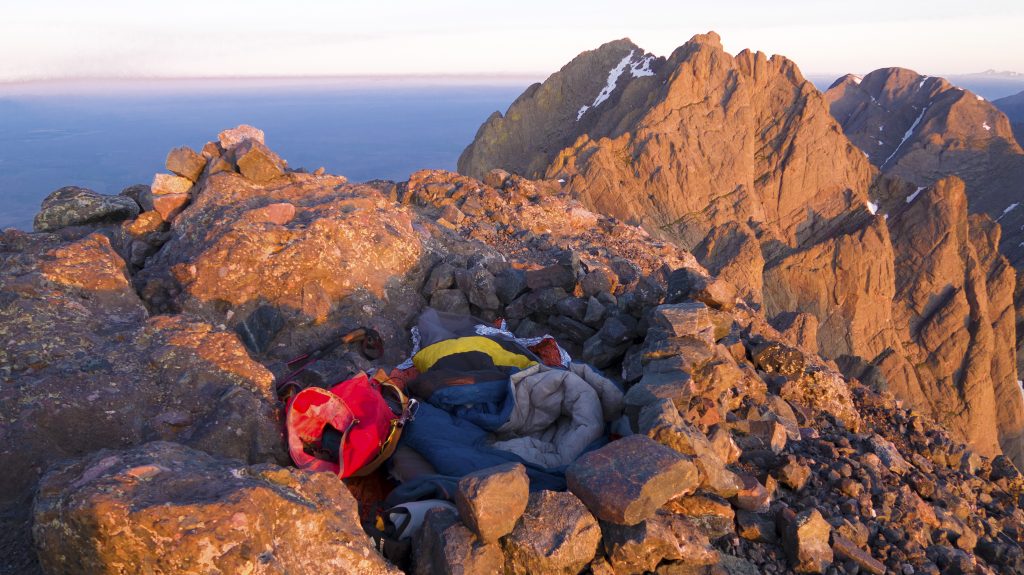
Sierra Designs Cloud 35
652 grams
A really great, warm, comfortable 35 degree sleeping bag. Zipper-less, and seemingly bulletproof to my abuse. I’ve had this bag for a few years now, and am surprised at how well it’s been working out for me. Definitely something I can suggest.
The Cloud 20 is most likely a more flexible bag, as its rating is much much higher. I sleep pretty warm, and supplement the 35 rating with a very warm pad, as well as wearing a down top and insulated bottom.
Therm-A-Rest NeoAir XTherm (cut down to ~4′)
335 grams
Another clutch piece of gear I’ve had for a long time, I find the XTherm’s warmth for its weight to be a great asset. I’ve punctured it multiple times, and been able to repair it well each time.
For the trip, I got slightly extreme and purposely cut it down to about 4′. Cutting the bottom, then ironing it back together actually worked! No regrets so far in using an even shorter pad.
A warm pad (that’s still light!) really helps in keeping the entire sleep system’s weight down and allowed me to get away with a 35 degree pad when bivvying at 14,000’+.
Ultimate Direction FK Bivy
188 grams
Lightweight, breathable (but not in any way water-resistent) bivy, mostly used to keep my bag + pad + pillow together, and clean. Bottom is basically my ground cloth.
The bug netting came in handy, as the mosquitoes in the Sangres this year were indeed completely out of control.
Sea to Summit 15D Escapist Tarp, M
300 grams
A good, lightweight tarp. I picked this up for a song at Sea to Summit’s annual warehouse sale. It’s basically a rectangular piece of nylon with guy lines attached. Only used once as a tarp, used often as a ground cloth, as well as packed piece of mind.
I picked this over my FK Tarp, as to well: tarp you need to stake the tarp down, and there’s just not many realistic places to set all that up above treeline.
Sea to Summit Aeros Ultralight Pillow, L
71 grams
Embarrassingly to say: I now use a camp pillow. Not very embarrassed to say: it was a great idea. Used while sleeping at night, as well as quick naps. Being comfortable equates to better sleep quality, be it for 10 minutes or three hours.
Probably not ever going to go without a pillow anymore. Call me old.
SOL Emergency Blanket
91 grams
Brought this for piece of mind, but used it as a ground cloth on the top of Crestone Needle for my bivy (used the tarp for a covering), and actually used it to wrap myself in during a brief hailstorm on my second to last day.
Also used it to questionable effects while melting snow, too: I would collect snow in a large, waterproof stuff sack, then wrap the back of the sack with the blanket, hoping to get some sort of passive oven effect. That would all then be stuffed in the back stretchy pocket of my Fastpack 45.
Happy to find that it is in fact: reusable, and can pack down pretty small. The bag it comes with is resealable.
Therm-A-Rest Z Seat Sit Pad
57 grams
I wondered of the actual utility of this little sit pad, but it turned out to be another piece of gear well worth its weight. First, think about the terrain I was on: 99% off-trail. Where are you going to sit if you need a break? Rocks, I guess.
Just the little bit of extra comfort allowed by this little pad helped make my trip that much enjoyable. Easy to deploy, easy to put back in the pack. Another piece of gear I don’t know if I’d do without.
I would also use it as a pad for my back when I took naps, as well as putting it down by my feet when sleeping for longer periods at night. The Z Seat Sit Pad weighed less than the material I removed from my XTherm, so the gamble seemed to pay off for me.
4 Small Stakes
40 grams
Used once. Probably small enough and light enough to I’d bring it along again on a similar trip.
Personal Items/Toiletries + Stuff Sack
Total: 319 grams
Personal items including:
- Sunscreen in stick form
- asthma inhaler
- toothbrush/toothpaste
- small backup lighter
- Aquamira (for treating water – used one night)
- Tenacious Tape
- Bug headnet
- Contact case/contact solution/extra contacts
- Stuff sack
Water System
Ultimate Direction Old School 20 Ounce Kicker Valve
99 grams
My main water carrying tool. Usually, I would only have this 20 ounce bottle filled with free-flowing water.
Smart Water 1 Liter Bottle
39 grams
Gotta be legit.
HydraPak Seeker 3 Liter
97 grams
I used this when I wanted to carry a lot of water at once. 3 liters of water weighs in at almost 3,000 grams/6.6 pounds, which is not to be dismissed when talking about carrying weight. Only a few times where I cameled up so heavy: second day up and over Mt. Zwischen being one of them, and I still badly ran out of water.
I also (tried) to us it to carry unmelted snow, but getting the snow into (and then out of) the small top opening proved problematic and frustrating. I instead used the waterproof stuff sack that I put my food in.
Nutrition
Total: 6025 grams/13.3 pounds
